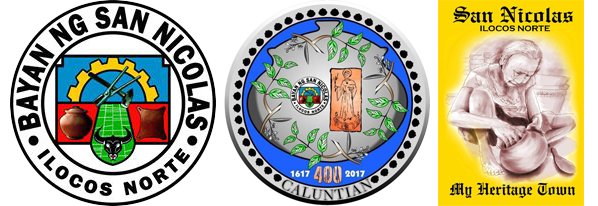Historical Background
On entering the southern approach of the Municipality of San Nicolas, Ilocos Norte, one is greeted by the grand elegance of an ancient tower, church and convent made of bricks and lime. They lie at the heart of San Nicolas beside the place where a beautiful plaza is situated. The three national roads, one from Manila on the south, another from Tuguegarao on the north and one from Nueva Era on the east converge at this place thus giving San Nicolas the blessing of commercial advantage.The industrious, gentle and hospitable people of San Nicolas assure the visitors of a heartfelt friendship and welcome.
The town of San Nicolas is located at the Central Western part of the Province of Ilocos Norte. It is bounded at the north by Laoag City and a part of Sarrat while at the east lies the main section of Sarrat and a fraction of Batac City. At the south is the central land of Batac City while at the west lies a part of Laoag City and Paoay.
San Nicolas is relatively a small town with its area of 60.11 square kilometers. It is now composed of 15 urban and nine rural barangays, and is populated by Ilocanos who descended from the Malayan race.
Before the Spaniards colonized the Philippines and came to San Nicolas, the rural areas of the town were populated by pagan Tinggians and Igorots. Earthen utensils were discovered at the rural sites where they used to live. However, with the coming of the Spaniards the pagans rejected Christianity and returned to the Cordilleras where they came from. Meanwhile, the Malayan descendants who resided at the urban areas embraced Christianity.
Augustinian missionaries founded a Visita or Spanish settlement at the site now known as San Nicolas. They named the VisitaCaluntian after a tree that grew abundantly at the place. Caluntian was attached as a Visita to the pueblo of Vigan. Augustinian friars stationed at Vigan periodically ministered to the spiritual needs of the people at the Visista of Caluntian. When the adjoining missionary settlement of Ylaua (now Laoag City)became a pueblo, the administration of Caluntian was transferred from Viagn to Ylaua. The Spanish Mapa of 1848 sets 1584 as the founding of San Nicolas. This must mean its foundation as a settlement or Visita, for the Libro de Govierno cites a “private definitory” ordering the separation of Caluntian from its Laoag Matrix in the year 1617. On said time it thus became an independent parish or pueblo under the name San Nicolas after the inhabitants’ favorite saint and acknowledged protector from natural calamities. The first parish priest was Fray Juan Estrada.
After the installation of a civil government in pueblos, Don Felipe Molina became the first governadorcillo of San Nicolas in 1733.
San Nicolas was occupied by the Katipuneros at the height of the Philippine revolt against Spain in 1998. Likewise, the American and Japanese soldiers occupied the religious and government buildings in 1990 and the latter part of 1941 respectively.
The Estado of 1612 (Spanish census records) reveals 2,496 souls (inhabitants). In 1760 the population rose to 4,793 souls. It became 9,532 in 1896 and 23,384 in 1980.
At the beginning of the Spanish regime, agriculture was the only source of the town’s economy. To create additional income, the Spanish government introduced home industries like blacksmithing, calesa and cart making, pottery and others. Since then, its pottery industry has been providing the earthenware needs of Ilocos Norte and Cagayan even to this day. The clay pot or banga became the symbol of the trade. After 1617, the pueblo of San Nicolas paid its first revenue of ten pesos ( P 10.00) to the San Agustin Monastery in Manila. The pueblo was classified poor so that from time to time it was annexed to Laoag as a mere village. When its economy improved, it was again separated and considered a pueblo. This condition persisted until the early part of the American regime. Finally, on January 1, 1909, it became an independent pueblo and was never again annexed to Laoag.
The economy of San Nicolas gradually improved under the American regime and the Philippine Republic. Its enterprising people modernized agriculture and established income-generating industries like iron works, food processing, furniture making and many others. Its economy greatly improved with the installation of the Coca –Cola Bottling Plant at San Nicolas on January 1, 1980.
The economic progress of San Nicolas saw the establishment of medical clinics, recreation facilities, lodging houses and many more.
The Venvi Corporation established an agro-commercial complex on the south eastern part of the town on hillsides which were not economically productive in past years. The Venvi Corporation has now utilized the place for its large scale poultry and swine production including feeds processing. Likewise, the northern part of San Nicolas which used to be submerged in water during rainy days is now filled up with earth and gravel. It is now the site of sprawling commercial center named “365” which houses stores, recreational facilities and other establishments. The Robinson’s Mall complex will rise on said place and become operational toward the end of 2009 or early 2010. This project is also run by the Venvi Corporation.
The economic improvements in the town peaked under the now two-term administration of Dr. Alfredo P. Valdez, Jr. The Construction of a big two-storey market begun by past local administrations is about to be completed.
The town of San Nicolas takes pride in its rich historical past. It invites you to come and visit the place.
Written by Atty. Manuel F. Aurelio
